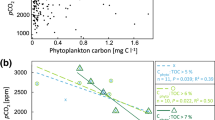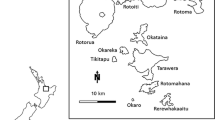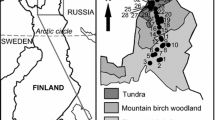Abstract
Organic and inorganic carbon concentrations in lakes and the links to catchment and water quality were studied in variable landscapes using the Finnish Lake Survey data base including 874 randomly selected lakes sampled during autumn overturn. The median total organic carbon (TOC) in these boreal lakes was 7.8 mg l−1, the median total inorganic carbon (TIC) 1.6 mg l−1 and the median partial pressure of CO2 (pCO2) 900 μatm. When the data was divided into subgroups according to land use in the catchment, the proportion of TIC of the total carbon (TC) in lakes was highest (31%) in agricultural areas and lowest (10%) in peatland areas. Elevated TIC concentrations were associated with agricultural land in the catchment, whereas elevated TOC concentrations were observed in lakes with high peatland proportion in the catchment. Two contrasting important sources of CO2 in lakes were identified on the basis of statistical analysis of the data; weathering processes in the catchments and decomposition of organic matter. CO2 was also strongly associated with total nutrients TN and TP, implying the importance of quality of organic matter and availability of nutrients for the decomposition processes.






Similar content being viewed by others
References
Andersson E, Kumblad L (2006) A carbon budget for an oligotrophic clearwater lake in mid-Sweden. Aquat Sci 68:52–64
Bade DL, Carpenter SR, Cole JJ et al (2007) Sources and fates of dissolved organic carbon in lakes as determined by whole-lake carbon isotope additions. Biogeochemistry 84:115–129
Billett MF, Garnett MH, Harvey F (2007) UK peatland streams release old carbon dioxide to the atmosphere and young dissolved organic carbon to rivers. Geophys Res Lett 34:L23401
Boyer JN, Groffman PM (1996) Bioavailability of water extractable organic carbon fractions in forest and agricultural soil profiles. Soil Biol Biochem 28(6):783–790
Butler JN (1982) Carbon dioxide equilibria and their applications. Addison-Wessley Publishing Company, Reading
Canham CD, Pace MP, Papaik MJ et al (2004) A spatially explicit watershed-scale analysis of dissolved organic carbon in Adirondack lakes. Ecol Appl 14:839–854
Cole JJ, Prairie YT, Caraco NF et al (2007) Plumbing the global carbon cycle: integrating inland waters into the terrestrial carbon budget. Ecosystems 10:171–184
Dawson JJC, Billett MF, Neal C et al (2002) A comparison of particulate, dissolved and gaseous carbon in two contrasting upland streams in the UK. J Hydrol 257:226–246
Dawson JJC, Billett MF, Hope D et al (2004) Sources and sinks of aquatic carbon in a peatland stream continuum. Biogeochemistry 70:71–92
Dillon PJ, Molot LA (1997) Dissolved organic and inorganic carbon mass balances in central Ontario lakes. Biogeochemistry 36:29–42
Findlay SEG, Sinsabaugh RL (2003) Aquatic ecosystems: interactivity of dissolved organic matter. Academic Press, San Diego
Findlay SEG, Quinn JM, Hickey CW (2001) Effects of land use and riparian flowpath on delivery of dissolved organic carbon to streams. Limnol Oceanogr 46(2):345–355
Gaillardet J, Dupré B, Louvat P et al (1999) Global silicate weathering and CO2 consumption rates deduced from the chemistry of large rivers. Chem Geol 159:3–30
Granéli W, Lindell M, Tranvik L (1996) Photo-oxidative production of dissolved inorganic carbon in lakes of different humic content. Limnol Oceanogr 41(4):698–706
Henriksen A, Skjelkvåle BL, Lien L et al (1996) Regional lake surveys in Finland–Norway–Sweden–Northern Kola–Russian Karelia–Scotland–Wales 1995. Coordination and design. Acid rain research report 40, NIVA, Oslo
Humborg C, Smedberg E, Blomqvist S et al (2004) Nutrient variations in boreal and subarctic Swedish rivers: landscape control of land–sea fluxes. Limnol Oceanogr 49(5):1871–1883
IPCC (2001) In: Houghton JT, Ding Y, Griggs DJ et al (eds) Climate change 2001: the scientific basis. Contribution of working group I to the third assessment report of the intergovernmental panel on climate change. Cambridge University Press, Cambridge
Johnson MS, Lehmann J, Couto EG et al (2006) DOC and DIC in flowpaths of Amazonian headwater catchments with hydrologically contrasting soils. Biogeochemistry 81:45–57
Juutinen S, Rantakari M, Kortelainen P et al (2009) Methane dynamics in different boreal lake types. Biogeosciences (in press)
Kling GW, Kipphut GW, Miller MC (1992) The flux of CO2 and CH4 from lakes and rivers in arctic Alaska. Hydrobiologia 240:23–46
Kortelainen P, Mannio J (1988) Natural and anthropogenic acidity sources for Finnish lakes. Water Air Soil Pollut 42:341–352
Kortelainen P, Mannio J, Forsius M et al (1989) Finnish lake survey: the role of organic and anthropogenic acidity. Water Air Soil Pollut 46:235–249
Kortelainen P, Rantakari M, Huttunen JT et al (2006) Sediment respiration and lake trophic state important predictors for the large CO2 evasion from small boreal lakes. Glob Chang Biol 12:1554–1567
Kritzberg ES, Cole JJ, Pace ML (2004) Autochthonous versus Allochthonous carbon sources of bacteria: results from whole-lake 13C addition experiments. Limnol Oceanogr 49(2):588–596
Lahermo P, Väänänen P, Tarvainen T et al (1996) Suomen geokemian atlas. Osa 3: Ympäristögeokemia–purovedet ja-sedimentit (Geochemical atlas of Finland. Part 3: environmental geochemistry—stream waters and sediments). Geologian tutkimuskeskus, Espoo. Geological survey of Finland, Espoo
Lauster GH, Hanson PC, Kratz TK (2006) Gross primary production and respiration differences among littoral and pelagic habitats in northern Wisconsin lakes. Can J Fish Aquat Sci 63:1130–1141
Mannio J, Räike A, Vuorenmaa J (2000) Finnish lake survey 1995: regional characteristics of lake chemistry. Verh Internat Verein Limnol 27:362–367
Meili M (1992) Sources, concentrations and characteristics of organic matter in softwater lakes and streams of the Swedish forest region. Hydrobiologia 229:23–41
Neal C, Hill S (1994) Dissolved inorganic and organic carbon in moorland and forest streams: Plynlimon, mid Wales. J Hydrol 153:231–243
Palmer SM, Hope D, Billett M, Dawson JJC, Bryant CL (2001) Sources of organic and inorganic carbon in a headwater stream: evidence from carbon isotope studies. Biogeochemistry 52:321–338
Plummer LN, Busenberg E (1982) The solubility of calcite, aragonite, and vaterite in CO2–H2O solutions between 0 and 90°C, and an evaluation of the aqueous model for CaCO3–CO2–H2O equilibria. Geochim Cosmochim acta 46:1011–1040
Rantakari M, Kortelainen P, Vuorenmaa J et al (2004) Finnish lake survey: the role of catchment attributes in determining nitrogen, phosphorus and organic carbon concentrations. Water Air Soil Pollut Focus 4:683–699
Raymond PA, Bauer JE (2001) Riverine export of aged terrestrial organic matter to the North Atlantic Ocean. Nature 409:497–500
Raymond PA, Cole JJ (2003) Increase in the export of alkalinity from North America’s largest river. Science 301:88–91
Raymond PA, Oh N-H, Turner RE, Broussard W (2008) Anthropogenically enhanced fluxes of water and carbon from the Mississippi river. Nature 451:449–452
Reche I, Pace ML, Cole JJ (1998) Interactions of photobleaching and inorganic nutrients in determining bacterial growth on colored dissolved organic carbon. Microb Ecol 36:270–280
Redfield AC, Ketchum BH, Richards FA (1963) The influence of organisms on the composition of seawater. In: Hill MN (ed) The sea, vol 2. Wiley, Chicherster
Salonen K, Vähätalo A (1994) Photochemical mineralisation of dissolved organic matter in lake Skjervatjern. Environ Int 20(3):307–312
SAS Institute (2001) SAS version 8.2 for windows. SAS Institute Inc, Cary
Sinsabaugh RL, Findley SEG (2003) Dissolved organic matter: out of the black box into the main stream. In: Findlay SEG, Sinsabaugh RL (eds) Aquatic ecosystems: interactivity of dissolved organic matter. Academic Press, San Diego
Smedberg E, Mörth C-M, Swaney DP et al (2006) Modeling hydrology and silicon–carbon interactions in taiga and tundra biomes from a landscape perspective: implications for global warming feedbacks. Glob Biogeochem Cycles 20:GB2014
Sobek S, Algesten G, Bergström A-K et al (2003) The catchment and climate regulation of pCO2 in boreal lakes. Glob Chang Biol 9:630–641
Striegl RG, Kortelainen P, Chanton JP et al (2001) Carbon dioxide partial pressure and 13C content of north temperate and boreal lakes at spring ice melt. Limnol Oceanogr 46:941–945
Striegl RG, Dornblaser MM, Aiken GR et al (2007) Carbon export and cycling by the Yukon, Tanana, and Porcupine rivers, Alaska, 2001–2005. Water Resour Res 43:W02411
Struyf E, Conley DJ (2008) Silica: an essential nutrient in wetland biogeochemistry. Front Ecol Environ 6. DOI 10.1890/070126
Stumm W, Morgan JJ (1981) Aquatic chemistry. An introduction emphasizing chemical equilibria in natural waters. Wiley, New York
Telmer K, Veizer J (1999) Carbon fluxes, pCO2 and substrate weathering in a large northern river basin, Canada: carbon isotope perspectives. Chem Geol 159:61–86
Walvoord MA, Striegl RG (2007) Increased groundwater to stream discharge from permafrost thawing in the Yukon River basin: potential impacts on lateral export of carbon and nitrogen. Geophys Res Lett 34:L12402
Wetzel RG (1983) Limnology, 2nd edn. Saunders Collage Publishing, Philadelphia
Williams M, Hopkinson C, Rastetter E et al (2005) Relationships of land use and stream solute concentrations in the Ipswich river basin, northeastern Massachusetts. Water Air Soil Pollut 161:55–74
Acknowledgments
This study was supported by the Academy of Finland. We thank Jussi Vuorenmaa for valuable help with water quality and catchment data.
Author information
Authors and Affiliations
Corresponding author
Rights and permissions
About this article
Cite this article
Rantakari, M., Kortelainen, P. Controls of organic and inorganic carbon in randomly selected Boreal lakes in varied catchments. Biogeochemistry 91, 151–162 (2008). https://doi.org/10.1007/s10533-008-9266-8
Received:
Accepted:
Published:
Issue Date:
DOI: https://doi.org/10.1007/s10533-008-9266-8




